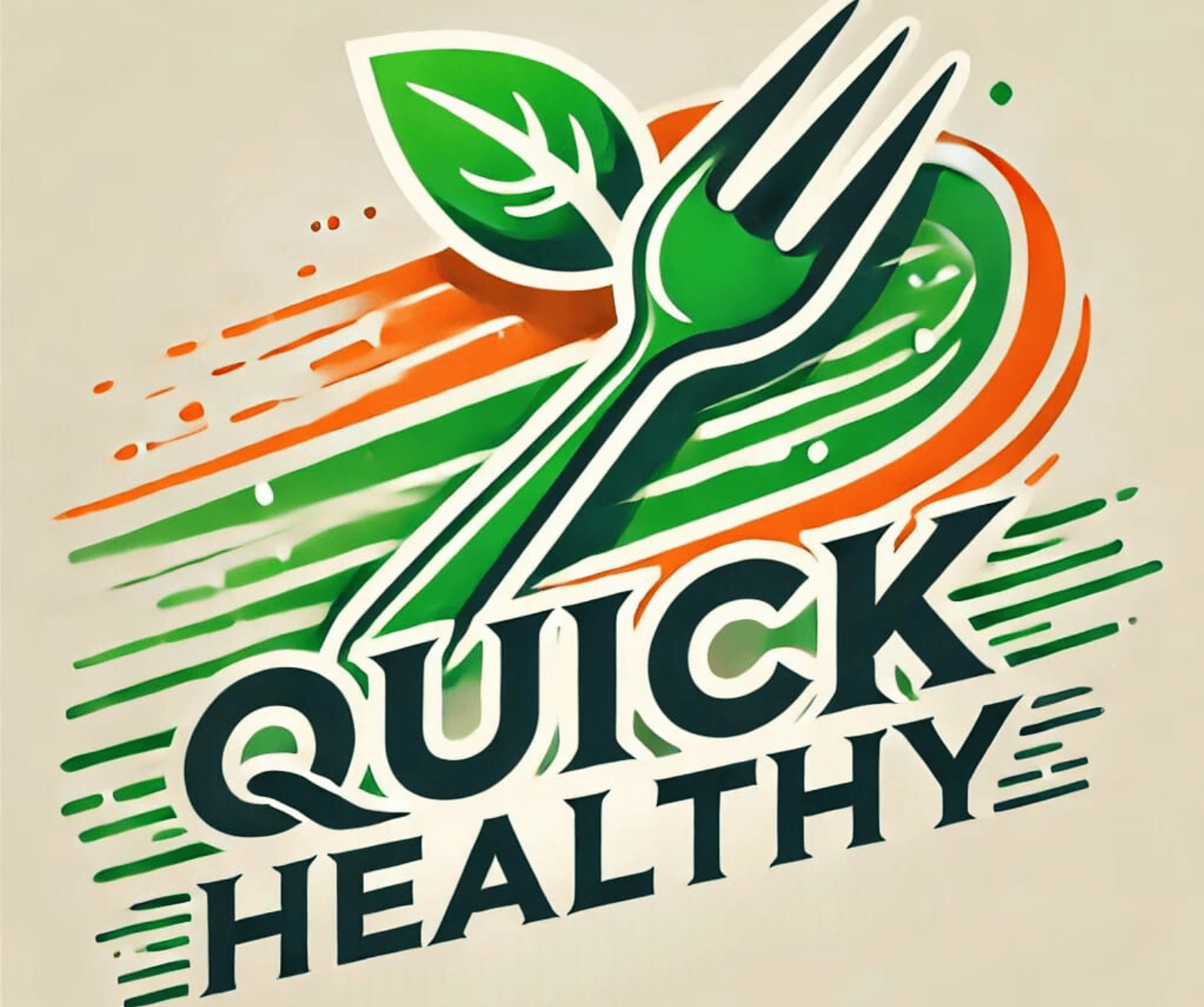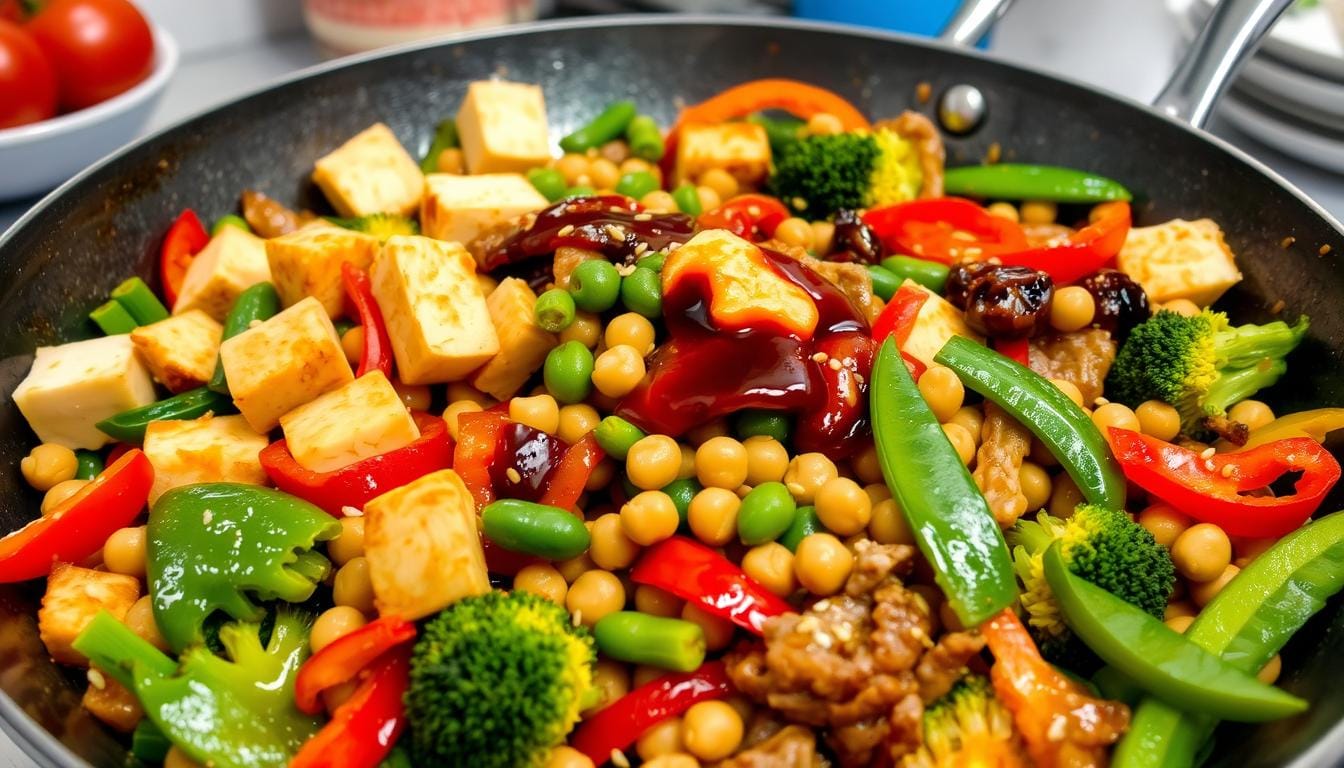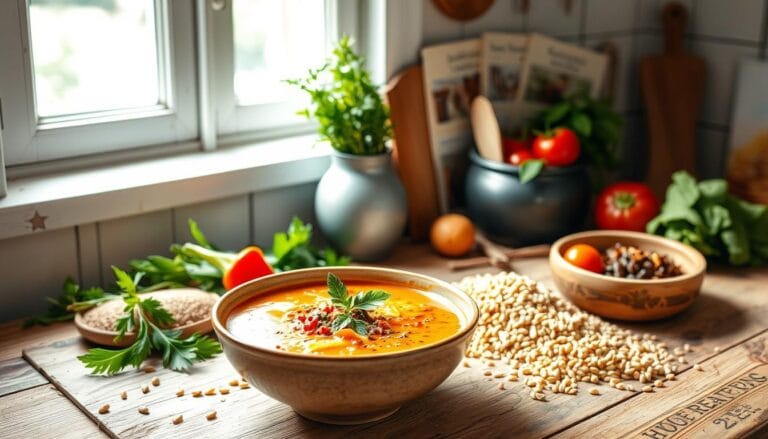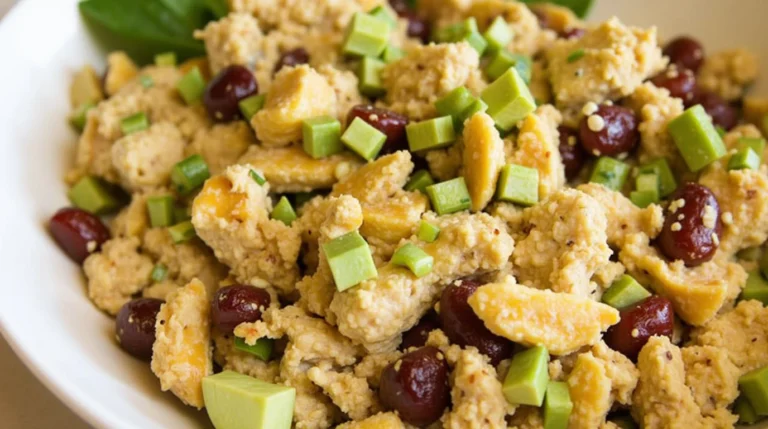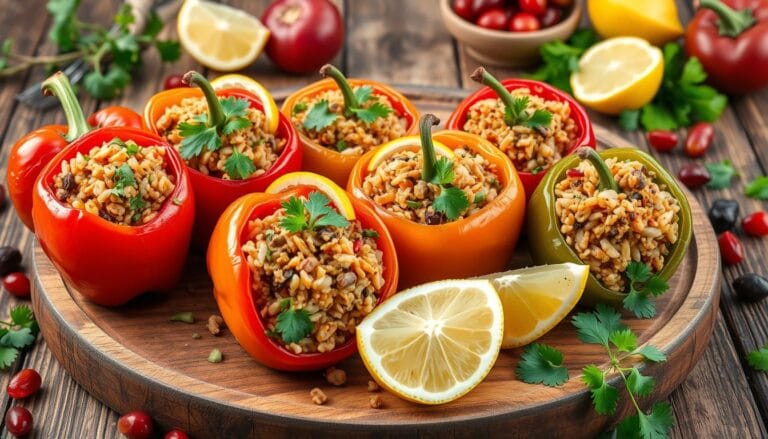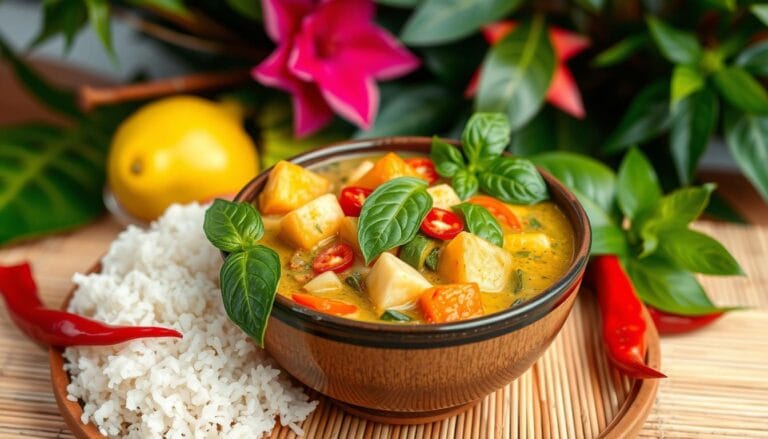Quick & Healthy Asian-Inspired Veggie Stir-Fry
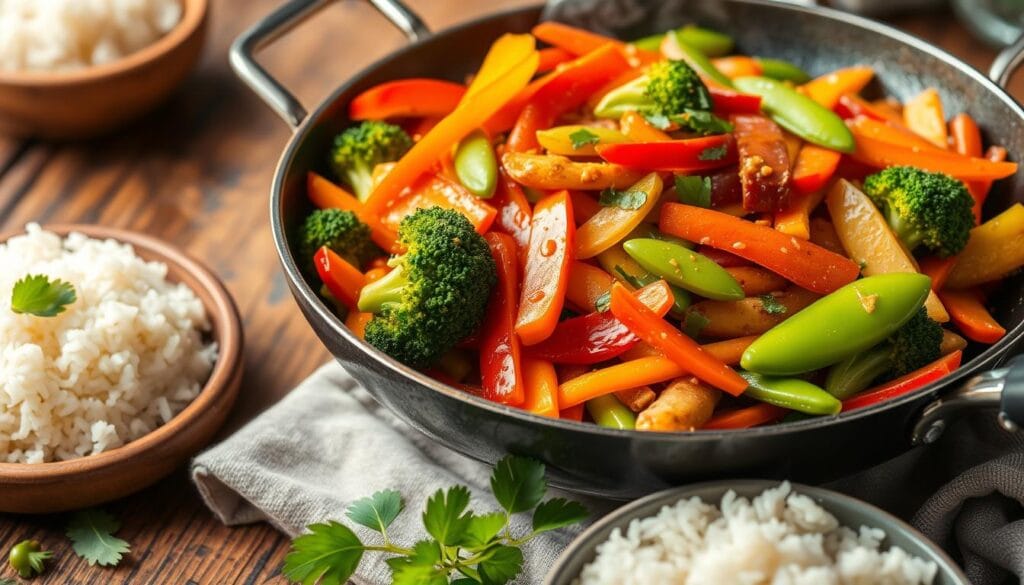
Table of Contents
Quick & Healthy Asian-Inspired Veggie Stir-Fry
Every busy weeknight, I’ve struggled to find a meal that’s both healthy and tasty. That’s when I found the magic of an Asian-inspired veggie stir-fry. It’s a quick, nutritious recipe that turns simple ingredients into a vibrant dish in just 20 minutes.
Imagine walking into your kitchen after a long day, wanting something fresh, fast, and full of flavor. This Asian-inspired veggie stir-fry is more than a meal. It’s a quick journey to a restaurant-quality taste at your dinner table, without spending hours cooking.
Stir-frying is not just a cooking method; it’s a way to explore vibrant flavors while staying healthy. You’ll learn to make a colorful, nutritious meal that pleases your taste buds and supports your health.
Whether you’re a busy professional, a health-conscious cook, or someone looking to try new vegetarian recipes, this guide will help. You’ll learn to make a perfect Asian-inspired veggie stir-fry with ease and confidence.
The Art of Creating Perfect Asian-Inspired Veggie Stir-Fry
Learning to stir-fry is all about precision and skill. It’s about turning simple vegetables into a work of art. Start by mastering the basics to create a dish that wows.
Stir-frying is more than cooking. It’s a dance that needs focus and quick moves. The right steps can make your dish stand out.
Essential Wok Techniques
Your wok is key in cooking with asian vegetables. You need to:
- Keep moving the ingredients
- Use high heat
- Quickly toss the food
- Keep the cooking surface even
Heat Management Tips
Managing heat is vital for a great stir-fry. Different temperatures help achieve different results:
| Heat Level | Purpose | Cooking Result |
|---|---|---|
| High Heat | Searing vegetables | Crisp outside, soft inside |
| Medium Heat | Gentle cooking | Even texture, no burning |
| Low Heat | Finishing sauces | Flavors blend smoothly |
Proper Vegetable Cutting Methods
Cutting vegetables right is crucial. Uniform sizes ensure even cooking and look great. Here’s how to do it:
- Use a sharp knife for clean cuts
- Cut all vegetables the same size
- Slice against the grain for tenderness
- Think about the vegetable’s density when cutting
“The secret to a perfect stir-fry lies in the preparation, not just the cooking.” – Chef Ming Tsai
Mastering these techniques will turn your kitchen into a place of delicious, authentic dishes. It celebrates the vibrant world of asian vegetables.
Essential Ingredients for Authentic Asian Flavors
Making a great asian-inspired veggie stir-fry begins with the right ingredients. It’s all about using fresh, top-quality items. These turn simple veggies into a dish that wows everyone.
Here’s what you need in your kitchen:
- Aromatics: Fresh ginger, garlic, and scallions
- Sauces: Soy sauce, oyster sauce, and sesame oil
- Seasonings: Rice vinegar and Chinese cooking wine
Now, let’s look at the key ingredients for a real asian-inspired veggie stir-fry:
| Ingredient | Flavor Profile | Culinary Purpose |
|---|---|---|
| Fresh Ginger | Spicy, Warm | Adds depth and aromatic complexity |
| Garlic | Pungent, Sharp | Provides fundamental savory base |
| Soy Sauce | Umami, Salty | Enhances overall seasoning |
| Sesame Oil | Nutty, Rich | Adds final aromatic finish |
“The magic of chinese-inspired cuisine lies not just in cooking technique, but in the harmonious blend of ingredients.” – Chef Ming Tsai
Knowing these ingredients will make your stir-fry amazing. Each part is key to a dish that’s full of flavor and color. It’s sure to impress anyone.
Selecting and Preparing Your Fresh Vegetables
Starting a tasty healthy stir fry means picking the right vegetables. Your dish’s success depends on choosing fresh, crisp produce. This produce should hold up well to quick, high-heat cooking.
Knowing which vegetables are best can make your cooking stand out. The trick is to pick produce that keeps its texture and taste even when cooked fast.
Best Vegetables for Stir-Frying
- Crisp bell peppers
- Tender bok choy
- Crunchy broccoli florets
- Slender snow peas
- Robust carrots
- Delicate mushrooms
Proper Cleaning and Cutting Techniques
Getting your vegetables ready for stir-frying needs care. First, wash them well under cold water. Then, dry them with clean towels to stop steam during cooking.
“Sharp knife, perfect slice: The secret to an amazing stir fry lies in uniform vegetable cuts.” – Professional Chef
Vegetable Preparation Timeline
- Wash vegetables (5 minutes)
- Dry completely (2-3 minutes)
- Chop into uniform pieces (10 minutes)
- Organize by cooking time (2 minutes)
Pro tip: Cut harder veggies like carrots smaller and quicker-cooking greens like spinach in bigger pieces. This helps ensure everything cooks evenly in your healthy stir fry.
The Perfect Stir-Fry Sauce Formula
Making the ultimate sauce is key to a great stir-fry. It turns simple veggies into a dish that’s truly special. It’s all about the flavors of chinese-inspired cuisine.
For a top-notch stir-fry sauce, you need to balance flavors. Here are the main parts:
- Salty Base: Soy sauce or tamari
- Sweet Element: Honey or brown sugar
- Acidic Touch: Rice vinegar or lime juice
- Umami Booster: Oyster sauce or mushroom-based alternative
Cornstarch is important for the sauce’s texture. It makes the sauce thick and coats the veggies well. This gives your dish a shiny, restaurant-like look.
“A great sauce is the difference between a good stir-fry and an unforgettable meal.” – Professional Chef Recommendation
When mixing your sauce, use a 3:1:1 ratio. This means three parts liquid, one part acid, and one part sweet. You can adjust this to taste, but remember, balance is crucial.
Pro tip: Mix your sauce ingredients separately before adding them to the wok. This helps prevent clumps and ensures even flavor.
Step-by-Step Cooking Process
Learning to make an easy stir fry is all about mastering cooking techniques. The right steps turn simple ingredients into a tasty, healthy dish.
Preheating and Oil Selection
Choosing the right oil is key for a great stir fry. Use oils with high smoke points like:
- Avocado oil
- Peanut oil
- Grapeseed oil
Heat your wok or skillet on medium-high until it’s hot but not smoking. A hot pan cooks food quickly and keeps veggies crisp.
Cooking Order for Ingredients
Here’s how to cook your stir fry:
- Begin with aromatics (garlic, ginger)
- Add longest-cooking veggies first
- Quick-cooking veggies go last
- Finish with delicate herbs
Timing and Temperature Control
Timing is everything in a stir fry. Move ingredients constantly and cook in batches to avoid overcrowding.
“The secret to a perfect stir fry is high heat and constant motion” – Professional Chef
| Vegetable Type | Cooking Time | Recommended Heat |
|---|---|---|
| Root vegetables | 4-5 minutes | High |
| Leafy greens | 1-2 minutes | Medium-high |
| Soft vegetables | 2-3 minutes | Medium |
Protein Options for Your Stir-Fry
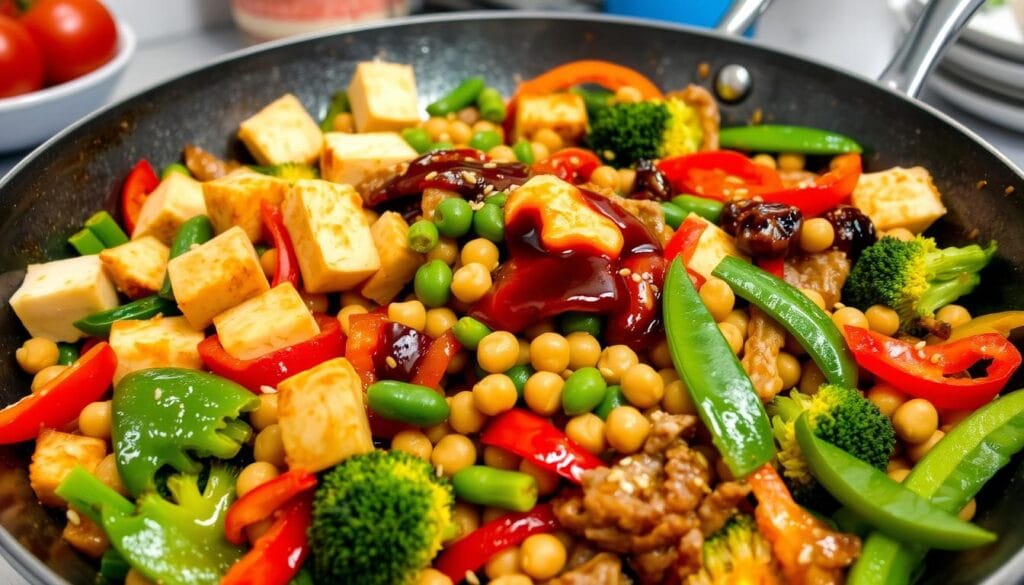
Starting a tasty tofu stir fry means picking the right protein. Plant-based meals are full of options for home cooks. They offer exciting ways to enjoy vegan stir fries.
Your main protein choices for a plant-based meal include:
- Tofu: The top pick for vegetarian stir-fries
- Firm tofu is best for keeping its shape
- Extra-firm tofu gets crispy when pan-seared
- Tempeh: A soybean protein with a strong taste
- It has a nutty flavor and a dense texture
- It’s packed with protein and probiotics
- Seitan: A wheat protein that feels like meat
- It’s great for making dishes taste like meat
- It soaks up sauces really well
When you’re getting ready your protein, press the tofu well. This gets rid of extra moisture. It makes the outside crispy and helps it soak up stir-fry sauces.
“The secret to great plant-based proteins is proper preparation and bold seasoning.” – Vegan Culinary Institute
Nutritional tip: Each protein has its own benefits. Tofu has calcium, tempeh has probiotics, and seitan has lots of protein. Try different combinations for varied and healthy vegan stir fry meals.
Common Mistakes to Avoid When Making Stir-Fry
Mastering an asian-inspired veggie stir-fry takes practice and knowing common mistakes. Even skilled cooks can face challenges that affect their dish’s quality.
Cooking a perfect stir-fry is an art that needs focus on details. Let’s look at some common mistakes that can ruin your dish.
Temperature Challenges
Temperature control is key for a great stir-fry. Low heat can make veggies soggy and flavorless. Your wok should be very hot before adding ingredients.
- Preheat your wok for 2-3 minutes
- Use high heat to create a quick sear
- Avoid cooking on medium or low temperatures
Wok Overcrowding Issues
Putting too many ingredients in your wok messes up the stir-fry. It stops heat from spreading and makes veggies steam instead of sear.
- Cook ingredients in small batches
- Leave space between vegetables
- Stir constantly for even cooking
Sauce Consistency Problems
A bad stir-fry can come from a wrong sauce. Thin or too thick sauces can ruin the taste and texture.
“The secret to a great stir-fry is balance in every element, especially the sauce.” – Professional Chef
Avoiding these mistakes can make your stir-fry go from good to great. Remember, practice makes perfect!
Health Benefits of Vegetable Stir-Frying
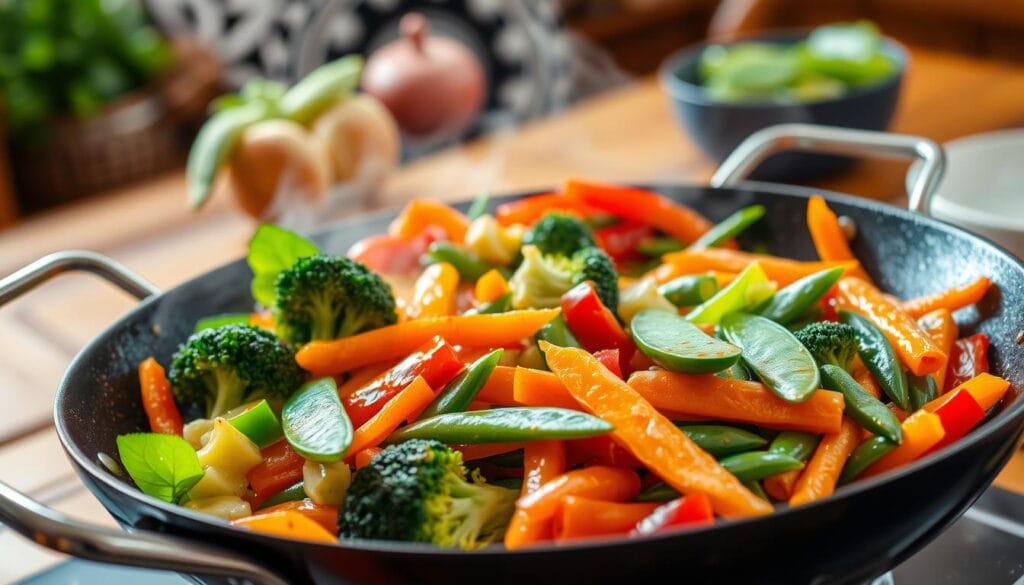
Turning your meals into a healthy stir fry is more than a fun cooking challenge. It’s a nutritional powerhouse. This method of cooking offers amazing health benefits, making vegetarian recipes both tasty and super good for you.
Stir-frying vegetables keeps more nutrients than other cooking methods. The quick, high-heat method helps keep nutrients in while keeping veggies fresh and colorful. Your body gets the most nutritional benefits with little effort.
- Retains up to 90% of vegetable nutrients
- Uses minimal oil for heart-healthy cooking
- Supports weight management goals
- Provides essential vitamins and minerals
“Stir-frying is not just cooking, it’s a nutrition-preserving art form.” – Culinary Nutrition Expert
The nutritional profile of a vegetable stir-fry is perfect for health-conscious people. These meals are low in calories but high in fiber. They help control weight and provide important nutrients.
| Nutrient | Amount per Cup | Health Benefit |
|---|---|---|
| Fiber | 3-5 grams | Improves digestion |
| Vitamin C | 50-80 mg | Boosts immune system |
| Antioxidants | High levels | Fights cellular damage |
Embrace the power of vegetable stir-frying as a delicious path to optimal health and wellness.
Serving Suggestions and Accompaniments
Turning your asian-inspired veggie stir-fry into a special meal is all about how you serve it. The right sides can make your dish unforgettable. It will please your taste buds and make your eyes happy.
For serving your chinese-inspired dish, think about these grains that go well with it:
- Jasmine rice
- Brown rice
- Quinoa
- Cauliflower rice
- Soba noodles
How you present your stir-fry is key to making it look good. Use wide, shallow bowls to show off the colors of your veggies. Add garnishes like:
- Chopped green onions
- Toasted sesame seeds
- Crushed peanuts
- Cilantro leaves
- Thin-sliced red chili
“The first bite is with the eyes” – Chinese Culinary Wisdom
Pair your stir-fry with traditional asian-inspired sides for a better dining experience. Light, fresh sides like cucumber salad or pickled veggies can cut the richness of your main dish.
The secret to a great stir-fry is not just in cooking. It’s also in the thoughtful presentation that highlights the beauty of chinese-inspired cuisine.
Storage and Leftover Tips
Keeping your easy stir fry recipe fresh is key. Smart storage helps keep the taste and nutrients intact. It’s all about how you store, cool, and reheat it.
Proper Cooling Methods
Quick cooling is vital for safety and quality. Here’s what to do:
- Let the stir fry cool to room temperature in 2 hours
- Use shallow containers to cool faster
- Split big portions into smaller ones
- Put it in the fridge at 40°F or below right away
Reheating Instructions
Reheating your stir fry needs care to avoid soggy veggies and flavor loss:
- Take the stir fry out of the fridge 15 minutes before heating
- Use a wok or large skillet for the best results
- Add a bit of water or broth to keep it moist
- Heat it on medium-high until it’s warm all the way through
Freezing Guidelines
| Ingredient | Freeze-Friendly | Best Practices |
|---|---|---|
| Vegetables | Partially | Blanch before freezing |
| Protein | Excellent | Store separately from vegetables |
| Sauce | Good | Freeze in airtight container |
“Proper storage transforms leftovers from boring to gourmet!” – Culinary Experts
By using these storage tips, your stir fry stays tasty and safe. This way, you reduce waste and keep the flavors strong.
Conclusion
Making an Asian-inspired veggie stir-fry is more than just cooking. It’s a way to make delicious, healthy meals. It turns your kitchen into a lively place.
With your new skills, you can make amazing plant-based meals fast. You’ll learn how to prepare veggies, use a wok, and mix flavors.
A healthy stir-fry is very flexible. You can try out different veggies, proteins, and sauces. This keeps your meals fresh and full of nutrients.
It’s great for busy people or anyone who loves cooking. You can make healthy dinners quickly without losing flavor.
Asian-inspired veggie stir-fry is a fun, lasting cooking skill. You’ll learn about managing heat, picking ingredients, and making sauces. It’s more than just cooking.
It’s about making dishes that are both tasty and good for you. Every meal is a chance to be creative and eat healthily.
Begin your stir-fry journey today. Your taste buds and health will appreciate it. This cooking method brings top-notch meals right to your table.
FAQ
What makes stir-frying a healthy cooking method?
Stir-frying is healthy because it uses little oil. It cooks food quickly, keeping nutrients in. This method also keeps vegetables crunchy and full of nutrients.
How do I choose the right vegetables for a stir-fry?
Pick fresh, firm veggies like bell peppers and broccoli. Choose ones that cook at the same time. Cut harder veggies thinly and add soft ones last to avoid overcooking.
Can I make a stir-fry if I don’t have a wok?
Yes, you can! A large skillet or sauté pan works great. Just use high heat and make sure the pan is big enough. A wide pan is good for electric stoves.
What are the best protein alternatives for vegetarian stir-fry?
Great options include tofu, tempeh, and edamame. Pressed tofu and marinated tempeh add flavor. These options make your stir-fry satisfying.
How can I prevent my stir-fry from becoming soggy?
To keep it crisp, heat your pan well before adding food. Cook in batches and don’t overcrowd. Use a dry pan and move ingredients fast.
What’s the ideal sauce-to-vegetable ratio for a stir-fry?
Use 2-3 tablespoons of sauce for 4 cups of veggies. The sauce should lightly coat them. Start small and add more if needed.
How long can I store leftover stir-fry?
Store it in the fridge for 3-4 days in an airtight container. Keep veggies and sauce separate from grains. Reheat in a pan to restore texture.
There are no reviews yet. Be the first one to write one.
